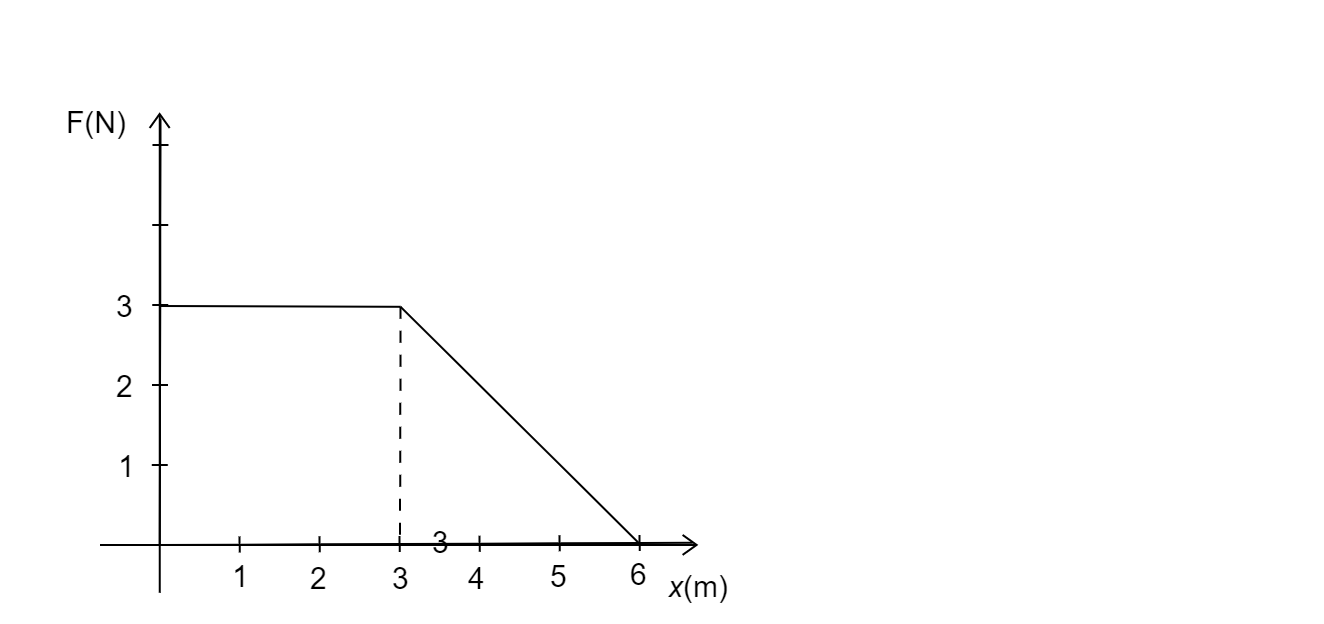
A force F acting on an object varies with distance x as shown in figure. The force is in N and x in m. The work done by the force in moving the object from $x = 0{\text{ to }}x = 6m$is:

(A) $13.5{\text{ J}}$
(B) $10{\text{ J}}$
(C) $15{\text{ J}}$
(D) $20{\text{ J}}$
Answer
216k+ views
Hint: Work is said to be done when a force produces motion in an object. The work done can be defined as the product of the force F and the displacement produced in the object, x. In a graphical form, F and x can be multiplied, and the area gives us the total value of the work done.
Complete step by step answer:
In a graphical representation of F vs x, we can integrate the curve and/or find the area enclosed between the two quantities.
This is the equivalent of multiplying in both quantities.
So, In the given graph we can divide the complex shape formed, into 2 simple shapes namely: A rectangle and a triangle.
Finding out areas of both these figures and adding them gives the value of total work done.
Area of triangle, ${A_1} = \dfrac{1}{2}bh$
From the graph, $b = 6 - 3 = 3$
$h = 3$
$\therefore {A_1} = \dfrac{1}{2} \times 3 \times 3$
${A_1} = 4.5Nm$
Now, Area of rectangle (square here)
${A_2} = {a^2}$
Where the side length, $a = 3$
${A_2} = {3^2}$
${A_2} = 9Nm$
The total work done, W is defined as:
$W = {A_1} + {A_2}$
$W = 4.5 + 9$
$W = 13.5Nm{\text{ or }}13.5J$
The correct option is (A).
Additional Information
Work done is highly dependent on the displacement of the body, no matter how much force is applied, if displacement or deformation of the body is zero, work done remains zero. It is a scalar quantity, but it is also a dot product of two vector quantities.
Note: If the shapes are given in forms of functions, then the work done can be calculated by integrating the function and applying limits, and adding up all the integrals. Even this question can be solved as an integral, but applying the formula for area simple shapes makes it easier to solve.
Complete step by step answer:
In a graphical representation of F vs x, we can integrate the curve and/or find the area enclosed between the two quantities.
This is the equivalent of multiplying in both quantities.
So, In the given graph we can divide the complex shape formed, into 2 simple shapes namely: A rectangle and a triangle.
Finding out areas of both these figures and adding them gives the value of total work done.
Area of triangle, ${A_1} = \dfrac{1}{2}bh$
From the graph, $b = 6 - 3 = 3$
$h = 3$
$\therefore {A_1} = \dfrac{1}{2} \times 3 \times 3$
${A_1} = 4.5Nm$
Now, Area of rectangle (square here)
${A_2} = {a^2}$
Where the side length, $a = 3$
${A_2} = {3^2}$
${A_2} = 9Nm$
The total work done, W is defined as:
$W = {A_1} + {A_2}$
$W = 4.5 + 9$
$W = 13.5Nm{\text{ or }}13.5J$
The correct option is (A).
Additional Information
Work done is highly dependent on the displacement of the body, no matter how much force is applied, if displacement or deformation of the body is zero, work done remains zero. It is a scalar quantity, but it is also a dot product of two vector quantities.
Note: If the shapes are given in forms of functions, then the work done can be calculated by integrating the function and applying limits, and adding up all the integrals. Even this question can be solved as an integral, but applying the formula for area simple shapes makes it easier to solve.
Recently Updated Pages
Circuit Switching vs Packet Switching: Key Differences Explained

Mass vs Weight: Key Differences Explained for Students

Alpha, Beta, and Gamma Decay Explained

Alpha Particle Scattering and Rutherford Model Explained

Angular Momentum of a Rotating Body: Definition & Formula

Apparent Frequency Explained: Formula, Uses & Examples

Trending doubts
JEE Main 2026: Application Form Open, Exam Dates, Syllabus, Eligibility & Question Papers

JEE Main Correction Window 2026 Session 1 Dates Announced - Edit Form Details, Dates and Link

Derivation of Equation of Trajectory Explained for Students

Hybridisation in Chemistry – Concept, Types & Applications

Understanding the Angle of Deviation in a Prism

Understanding Collisions: Types and Examples for Students

Other Pages
JEE Advanced Marks vs Ranks 2025: Understanding Category-wise Qualifying Marks and Previous Year Cut-offs

Units And Measurements Class 11 Physics Chapter 1 CBSE Notes - 2025-26

NCERT Solutions For Class 11 Physics Chapter 8 Mechanical Properties Of Solids

Motion in a Straight Line Class 11 Physics Chapter 2 CBSE Notes - 2025-26

NCERT Solutions for Class 11 Physics Chapter 7 Gravitation 2025-26

How to Convert a Galvanometer into an Ammeter or Voltmeter




